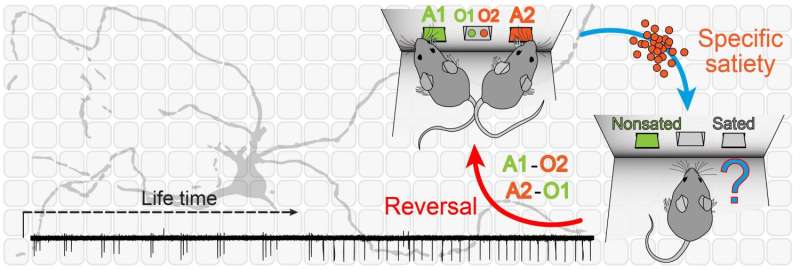Why you can't teach an old mouse new tricks

The ability to adapt to changes in the environment is key to survival, but this type of behavioral flexibility is often impaired in older individuals. A study in mice published April 20, 2016 in Neuron shows that the age-related decline in forming new behaviors is partly due to the deterioration of a brain circuit that plays a key role in goal-directed learning.
The findings suggest that through faulty activation of this brain circuit, new and old learning actively interfere in older mice, impairing their ability to select the most appropriate action in response to a changing environment, which leads to confusion.
"Flexibility issues in aging have long been described in other navigation and spatial memory tasks. Here we describe a similar flexibility problem but applied to goal-directed action, which of course has more detrimental consequences for everyday life and potentially compromises survival," says J. Bertran-Gonzalez of the University of Queensland. "This flexibility problem could constitute a first step towards major motivational decline and, in some cases, seed further cognitive conditions and dementia."
The ability to make choices between distinct courses of action depends on a brain region called the striatum, located in the forebrain and associated with planning and decision making. However, it has not been clear whether the age-related decline in striatal function impairs initial goal-directed learning per se or simply prevents the updating of this learning in face of new environmental demands.
To find out, Bertran-Gonzalez and his team placed aged mice in a chamber and trained them to press two levers: one to receive a grain-based food reward, and the other to receive a food pellet that was identical except that it had a sweet taste. Then the mice were placed in another box, where they were given unrestricted access to only one of the pellets—say, grain-based pellets—for an hour. Immediately afterward, the mice were again placed in the original chamber and allowed to choose between the differently flavored food pellets. Both young and old mice preferred to eat the sweetened food pellets because they were tired of eating the grain-flavored pellets.
The researchers next switched the action-outcome associations, such that pressing lever one resulted in the delivery of sweetened food pellets, whereas lever two presses yielded grain-flavored pellets. Young mice successfully adjusted to this environmental change, pressing lever one to receive the sweetened food pellet after having gorged on the grain-based food pellets, and vice versa. However, old mice became confused and pressed the two levers at similar rates.
This age-related decline in behavioral flexibility was accompanied by the deterioration of a specific pathway in the brain, called the parafascicular-to-cholinergic interneuron pathway (PF-to-CIN), which resulted in faulty activation of striatal neurons. Disrupting this pathway in young mice recapitulated the behavioral deficits observed in old mice, resulting in interference between old and new action-outcome associations. Taken together, the findings show that the age-related decline in the PF-to-CIN pathway impairs the ability of mice to adjust to environmental changes in goal-directed learning tasks.
The researchers are currently conducting several experiments examining other age-related alterations of goal-directed action that further contribute to motivational deficits, which are very common in the elderly but are often overlooked and confused with other age-related conditions.
"We think that it is of utmost importance that motivational decline is considered as a condition in its own right, so that strategies can be efficiently implemented early on to prevent motivational problems in the aged," Bertran-Gonzalez says. "In addition to extending the quality of life in the elderly, efficient restoration of motivational behaviors could in some cases reduce the risk of further cognitive decline and progression to dementia."
More information: Neuron, Matamales and Skrbis et al.: "Aging-Related Dysfunction of Striatal Cholinergic Interneurons Produces Conflict in Action Selection" DOI: 10.1016/j.neuron.2016.03.006

















